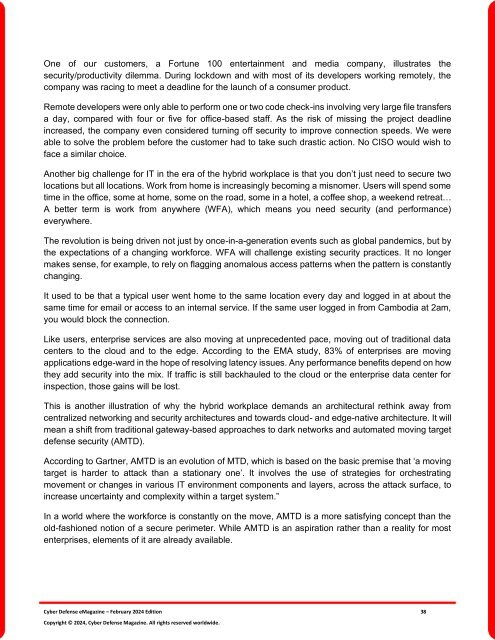The Cyber Defense eMagazine February Edition for 2024
Cyber Defense eMagazine February Edition for 2024 #CDM #CYBERDEFENSEMAG @CyberDefenseMag by @Miliefsky a world-renowned cyber security expert and the Publisher of Cyber Defense Magazine as part of the Cyber Defense Media Group as well as Yan Ross, Editor-in-Chief and many more writers, partners and supporters who make this an awesome publication! 155 page February Edition fully packed with some of our best content. Thank you all and to our readers! OSINT ROCKS! #CDM #CDMG #OSINT #CYBERSECURITY #INFOSEC #BEST #PRACTICES #TIPS #TECHNIQUES
Cyber Defense eMagazine February Edition for 2024 #CDM #CYBERDEFENSEMAG @CyberDefenseMag by @Miliefsky a world-renowned cyber security expert and the Publisher of Cyber Defense Magazine as part of the Cyber Defense Media Group as well as Yan Ross, Editor-in-Chief and many more writers, partners and supporters who make this an awesome publication! 155 page February Edition fully packed with some of our best content. Thank you all and to our readers! OSINT ROCKS! #CDM #CDMG #OSINT #CYBERSECURITY #INFOSEC #BEST #PRACTICES #TIPS #TECHNIQUES
Create successful ePaper yourself
Turn your PDF publications into a flip-book with our unique Google optimized e-Paper software.
One of our customers, a Fortune 100 entertainment and media company, illustrates the<br />
security/productivity dilemma. During lockdown and with most of its developers working remotely, the<br />
company was racing to meet a deadline <strong>for</strong> the launch of a consumer product.<br />
Remote developers were only able to per<strong>for</strong>m one or two code check-ins involving very large file transfers<br />
a day, compared with four or five <strong>for</strong> office-based staff. As the risk of missing the project deadline<br />
increased, the company even considered turning off security to improve connection speeds. We were<br />
able to solve the problem be<strong>for</strong>e the customer had to take such drastic action. No CISO would wish to<br />
face a similar choice.<br />
Another big challenge <strong>for</strong> IT in the era of the hybrid workplace is that you don’t just need to secure two<br />
locations but all locations. Work from home is increasingly becoming a misnomer. Users will spend some<br />
time in the office, some at home, some on the road, some in a hotel, a coffee shop, a weekend retreat…<br />
A better term is work from anywhere (WFA), which means you need security (and per<strong>for</strong>mance)<br />
everywhere.<br />
<strong>The</strong> revolution is being driven not just by once-in-a-generation events such as global pandemics, but by<br />
the expectations of a changing work<strong>for</strong>ce. WFA will challenge existing security practices. It no longer<br />
makes sense, <strong>for</strong> example, to rely on flagging anomalous access patterns when the pattern is constantly<br />
changing.<br />
It used to be that a typical user went home to the same location every day and logged in at about the<br />
same time <strong>for</strong> email or access to an internal service. If the same user logged in from Cambodia at 2am,<br />
you would block the connection.<br />
Like users, enterprise services are also moving at unprecedented pace, moving out of traditional data<br />
centers to the cloud and to the edge. According to the EMA study, 83% of enterprises are moving<br />
applications edge-ward in the hope of resolving latency issues. Any per<strong>for</strong>mance benefits depend on how<br />
they add security into the mix. If traffic is still backhauled to the cloud or the enterprise data center <strong>for</strong><br />
inspection, those gains will be lost.<br />
This is another illustration of why the hybrid workplace demands an architectural rethink away from<br />
centralized networking and security architectures and towards cloud- and edge-native architecture. It will<br />
mean a shift from traditional gateway-based approaches to dark networks and automated moving target<br />
defense security (AMTD).<br />
According to Gartner, AMTD is an evolution of MTD, which is based on the basic premise that ‘a moving<br />
target is harder to attack than a stationary one’. It involves the use of strategies <strong>for</strong> orchestrating<br />
movement or changes in various IT environment components and layers, across the attack surface, to<br />
increase uncertainty and complexity within a target system.”<br />
In a world where the work<strong>for</strong>ce is constantly on the move, AMTD is a more satisfying concept than the<br />
old-fashioned notion of a secure perimeter. While AMTD is an aspiration rather than a reality <strong>for</strong> most<br />
enterprises, elements of it are already available.<br />
<strong>Cyber</strong> <strong>Defense</strong> <strong>eMagazine</strong> – <strong>February</strong> <strong>2024</strong> <strong>Edition</strong> 38<br />
Copyright © <strong>2024</strong>, <strong>Cyber</strong> <strong>Defense</strong> Magazine. All rights reserved worldwide.

















